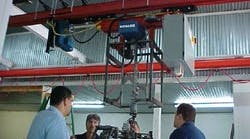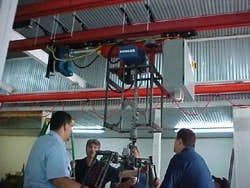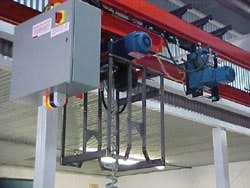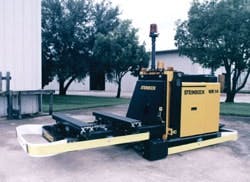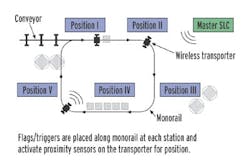Once in a while, every machine builder should step back for a moment to appreciate the marvels and near-marvels of automation that they and their industry brethren, their customers, and system integrators collectively create.
Modern automobile or truck manufacturing and assembly plants, for example, are technological wonderlands. Parts and assemblies move from station to station with little or no human intervention. Welding, painting, fastening and other operations are performed by sophisticated robots moving in time to an unheard symphony.
One of the key technologies that enables a modern auto plant to run smoothly is wireless communications. Transport and conveying systems are mobile and need to communicate with centralized control and information systems. Without wireless, these systems must communicate via cumbersome wiring harnesses or via manual operator interactions.
Wireless is a technology some machine builders are already very familiar with. And for those industrial OEMs that haven't yet dealt with it, the word is out. You soon will.
Case in Point
There are four "transporters" on the monorail. Each transporter is a hoist-and-trolley assembly using a custom-designed tool that carries a rear axle. A soft logic controller coordinates movement. Operators are stationed at four locations, each performing a specific task as part of the assembly process.
The four soft logic controllers are networked back to a central control station. Communications among the controllers is via a wireless communicator module, which enables communications directly with the controller backplane. The wireless modules communicate with each other via a 2.4-GHz spread-spectrum wireless link.
Metrolina Ergonomic Solutions, McMinnville, Tenn., an equipment manufacturing, service, and distribution company with a special emphasis on ergonomic material handling systems, was contacted by Nissan ti evaluate the original conveying system design. "The entire conveying system was basically a manual operation," says Roger Boivin, Metrolina's southeast region vice president. "The system had poor ergonomics and inefficient space utilization," he says. "We felt a wireless automation solution could greatly improve operations."
Each of our four tansporters is a monorail-guided, hoist-and-trolley assembly overseen by a sft logic controller, all of which are networked wiressly to a central control station.
Metrolina designed and fabricated the transporters and supplied the Demag Corp.-built monorail hoist and drive systems. Metrolina and Demag designed the entire conveying system. The wireless control system was designed, installed, and commissioned by Metrolina.No special programming was required for the communication link because the wireless communicator module is recognized and used by the soft logic controller as standard I/O. "Implementation by a PLC programmer is fairly simple and straightforward, as there is no proprietary software or hardware to configure," says Ben Brechtel, technical sales engineer with Control Chief , supplier of wireless communication module. "Exchange of data among the controllers is done via the wireless modules' dedicated I/O image tables. This provides a reliable and deterministic control medium directly integrated into the backpane of the SLC 500."
Control Chief develops wireless remote control systems for industrial environments. The company believes that for safety, reliability, and productivity, many industrial operations and equipment are best controlled from a safe distance via a wireless link. Control Chief supplied the wireless control hardware for the project, and also participated in the PLC software development.
Why Wireless?
"Before the system was upgraded with wireless automation, each operator manually maneuvered the axles from station to station," says Brechtel. "The new system is more efficient and requires less human effort." He says production with the new system has increased while maintenance of the equipment has decreased, producing a more cost-effective and profitable operation.
Nissan found the entire axle transport and assembly operation could be operated with one less person. "That should provide a two-year payback to Nissan," says Robert Koehler, president and CEO, Metrolina. "And this payback does not take into account any ergonomic issues that may have existed with the old, manual system."
The wireless solution coupled with the overhead monorail architecture also created opportunities to make other operating improvements. "Floor space could be better used for the staging of components, and operator safety was improved," adds Kohler. "The wireless system enabled the operators to focus on their required tasks at the workstations and eliminated the need for the physical manipulation of components from workstation to workstation."
Additional wireless controls could further improve operations. "Improvements to the onboard manual controls of the transporter could decrease maintenance even further," adds Brechtel. "Currently the raise/lower/forward/reverse controls are festooned from the tool up and around the hoist chain to the control cabinet and finally into the PLC. This festooning is in constant frictional contact with the hoist chain, which worsens as the tool is spun around."
As with many manual operations, inadvertent actions happen. "Unintentionally, the operators will sometimes wrap the festooned cable around the hoist chain," says Brechtel. "This causes cable wear and eventually necessitates cable replacement. A solution would be to use a wireless control pendant mounted to the tool. This would eliminate the festoon and would do away with the cost of maintenance and downtime associated with repairing the festooned cables."
Wireless Guidance
Automated guided vehicles (AGVs) were one of the first applications for wireless control and communication. Before wireless, AGV movement was controlled by wires embedded in the floor. Wireless systems coupled with precise positioning freed AGVs from floor wires and gave the vehicles the freedom to move anywhere in the factory.
Professional Materials Handling , Orlando, Fla., designs, fabricates, and installs material handling and conveying systems. PMH recently completed an automated material handling project for a pharmaceutical firm, and the project made extensive use of AGVs.
The pharmaceutical company uses an automated machine to fill plastic containers of various sizes with different liquid products. These containers are placed in large wire baskets that are 5 ft. long, 3 ft. wide, and 4 ft. tall. A wire basket filled with containers weighs 800-1,200 lbs.
When the sterilization machine is ready to run a batch, an AGV is automatically dispatched to move a wire basket from the staging area to the sterilization area. After sterilization the basket is emptied. Empty baskets are placed in a loading area, and an AGV is dispatched to move each basket to the fill machine.
"Precise, coordinated, and timely movement of the baskets is critical because each container must be sterilized within 24 hours of filling," says Bob Williams, software applications engineer and manager with PMH. "A central control system tracks the location of each AGV, the location of each wire basket, and the status of the filling and sterilization machines. The control system uses this information to dispatch the AGVs."
The central control system performs traffic control, movement logic, scheduling, status information, and area inventory. Control of all vehicle actions is accomplished by wireless communications. Sensors are used to indicate when full baskets are ready for pickup, and other sensors determine if a staging lane is fully occupied. Based on sensor status, the central control system controls the automatic movement of baskets from designated areas in the fill area to the staging area, and it also keeps track of basket locations.
Each AGV houses a 2.4-GHz, frequency-hopping, spread-spectrum radio modem manufactured by Cirronet (http://www.cirroet.com). Wireless communications can be susceptible to industrial factory noise, but Cirronet says its products overcome these limitations due to their high immunity to jamming and multipath fading.
Rather than specifying radios with the highest possible data rate (with an attendant reduction in range), middle-of-the-road products provide more than enough throughput for factory and industrial applications without sacrificing the needed range. "Cirronet designed in additional filtering and uses a double-conversion demodulation process to provide unsurpassed radio performance in the face of RF noise," adds Tim Cutler, vice president of sales and marketing for Cirronet.
OEMs such as PMH must be aware of throughput limitations and must design their systems with this constraint in mind. "Each message is kept relatively small so it will fit within one buffer size of the modem in case retries are needed," says Williams. "The modems guarantee an error-free transmission of the message and have a configurable retry count."
Just a Start
Many plant operations involving mobile transport and conveying systems could be improved with wireless control systems. "Potential applications in automotive plants in particular and manufacturing plants in general are endless," says Metrolina's Boivin. "Many complicated transfer systems can be simplified by using the wireless monorail concept."
The use of an on-board PLC mounted on a mobile transport unit gives system designers great flexibility. "The real beauty of a system like this is the ability to reuse the major control components for future system upgrades or complete system redesign," adds Boivin. "The PLC program controls the system instead of traditional hard-wired controls, so it is very easy to modify the controls."
Rockwell Automation (http://www.rockwellautomation.com), a primary hardware vendor for the Nissan project, offers a variety of wireless solutions. "The clear advantage to wireless is mobility and freedom. If wires are a problem--either the cost of installing them or maintaining them--wireless is an obvious option," says Andreas Somogyi, Rockwell Automation practice leader of Industrial Network Solutions. "Wireless is tailor-made for applications that involve equipment with significant motion, such as a crane. That's because the cable harnesses traditionally used to network this type of machine tend to break frequently, causing downtime and inflating maintenance costs."
HMI is another area where wireless communications can provide substantial benefit. "As the displays on machines continue to outnumber the available operators, it is more cost-effective to have a mobile interface," adds Somogyi. "Now, all the operator has to do is carry a single display around the floor."
In many cases, these wireless interfaces can be PDAs that communicate with a variety of control and monitoring systems, often via an Internet browser. It is technically feasible for each operator to have a personalized PDA equipped with a wireless web browser and a high-speed data link to the Internet.
It is also possible to upgrade or supply each machine control system as a web server. This allows an operator to communicate with each machine via his or her personal PDA. Each web server can be configured to provide custom web pages to each operator, based on personal preferences. A maintenance technician might be served web pages showing required maintenance. A supervisor could be served web pages displaying production data.
As with all technologies, wireless must be correctly and carefully applied. "Wireless is not without flaws," concludes Somogyi. "Data throughput is not guaranteed because wireless devices usually run at the fastest speed they can support in a given environment. So depending on the distance from the antenna, the number of devices, and the amount of noise in the area, the actual throughput may vary significantly."
Brechtel also sees other benefits of wireless control for mobile components. "Wireless controls make for a shortened installation period, decreased hardware, and less maintenance for the overall system," he says. "Any process or material handling applications in which hardwiring controls is cost or labor-intensive due to distance or mobility is a prime candidate for wireless control systems."
Driving the Other Vehicles at Nissan
Each transporter in the Smyrna, Tenn., Nissan plant begins its journey around the monorail loop at Position I. Positions I, III, and V are staging positions. Position II is where axle loading takes place, and Position IV is where the axle is unloaded.
Once the transporter reaches Position II, it stops automatically and the operator is given local control of all manual hoist and trolley functions. "The status of the stack lights changes to indicate the transporter is in manual mode. The operator then lowers the attachment assembly to load the axle using the pushbutton pendant located on the attachment tool," says Roger Boivin, southeast region vice president, Metrolina Ergonomic Solutions.
After the Position II operator is correctly positioned with respect to the axle assembly on the conveyor, he pushes the tracking pushbutton on the attachment tool pendant. This causes the transporter to continue to follow the axle conveyor at a predetermined speed. Once axle loading is completed, the operator raises the axle and attachment assembly into the nesting frame. A preset hoist limit-switch position then initiates the auto-send function and returns the transporter to auto wireless control mode.
The auto-mode transfers control of the transporter to the wireless PLC network. Because the central PLC knows the location of each transporter, it can control transporter movement and decide when to move the transporters from one position the next. The auto-mode also controls other transporter actions such as raising the axle to the hoist upper limit before moving from Position II to Position III.
Whenever the transporter is in the auto wireless control mode the stack lights show the operators that the transporter is under automatic control and that all manual control functions are locked out. Position III is a staging position for Position IV.
After the transporter arrives at Position III, the operator again has control of the manual functions via the pendant. The axle springs are added to the axle assembly, and the then operator lowers the attachment assembly and unloads the axle. At the completion of axle unloading, the operator raises the attachment assembly to the preset hoist limit switch position and the auto-send function is initiated. The transporter then raises the axle to the hoist upper limit and proceeds to staging Position V.
Position V is a staging position for Position I. If Position I is occupied the transporter will stop at Position V and wait for a wireless signal from the PLC master before proceeding.
